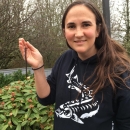An established population of nonnative Brook Trout resides in Tyee Springs directly upstream from Carson National Fish Hatchery. The potential for Brook Trout to escape from Tyee Springs and enter the hatchery is a concern because the hatchery releases spring Chinook yearlings into the Wind River as well as the South Fork Walla Walla River, a regional stronghold for ESA-listed Bull Trout. Past attempts to suppress the Brook Trout population have proven unsuccessful at eradicating the unwanted population. The Trojan Y Chromosome technique is a biological control strategy that is gaining popularity as an invasive fish management tool. This method involves producing male Brook Trout with two Y-chromosomes (Myy) which are then released into the population targeted for eradication. Offspring of YY males and resident females (XX) are all male (XY), so eventually the population becomes skewed toward a single sex, leading to extirpation of the target population. The Columbia River Fish and Wildlife Conservation Office, Abernathy Fish Technology Center, and Carson National Fish Hatchery initiated a collaborative proof-of-concept assessment of stocking Myy Brook Trout to eradicate nonnative Brook Trout in Tyee Springs. The purpose of this study was to collect demographic information from the resident Brook Trout population and perform a population simulation exercise to evaluate the feasibility of using Myy fish to eradicate nonnative Brook Trout in Tyee Springs. Results from simulations indicate that eradication of nonnative Brook Trout is possible using the Trojan Y-chromosome technique and that time to eradication generally decreases with increases in annual fish suppression rates. Consistent with other Myy simulation work, stocking Myy fish at 50% of the resident Brook Trout population (3,000 fish) and suppressing 50% of the resident population annually would lead to an 80% probability of eradication within nine years. Given suppression rates will likely decline over time, we tested suppression rate as a function of abundance, incrementally reducing the suppression rate as resident Brook Trout abundance declines. Under these conditions, the estimated number of years to eradication increased to 13 years versus 9 years when suppression was held at a constant 50%. A possible alternative to expending more effort to suppress the resident population would be to increase Myy stocking rates. However, sensitivity analyses indicate that there is no difference in time to eradication between stocking 3,000 or 7,000 Myy Brook Trout at suppression rates ≥25%. Given uncertainty surrounding the effectiveness of fish removal efforts along with survival and reproductive fitness of Myy fish once they are stocked into Tyee Springs, it will be necessary to utilize an adaptive management approach for the duration of the project. We recommend using annual fish removal events as an opportunity to monitor the population and collect additional information to update and improve the population model that will in turn inform and guide future fish removal and stocking efforts. Successful eradication of nonnative Brook Trout in Tyee Springs will remove a direct threat to Carson National Fish Hatchery and ESA-listed bull trout in the South Fork Walla Walla River. This project will help inform invasive fish eradication efforts and will be one of the first studies to assess how well the simulation model predicts the time to eradication of a nonnative Brook Trout population in a natural stream using the Trojan Y Chromosome technique.
Publication date
Facility




